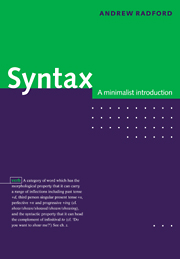1 - Grammar
Published online by Cambridge University Press: 05 June 2012
Summary
Grammar is traditionally subdivided into two different but inter-related areas of study – morphology and syntax. Morphology is the study of how words are formed out of smaller units (traditionally called morphemes), and so addresses questions such as ‘What are the various component parts (= morphemes) of a word like antidisestablishmentarianism, and what kinds of principles determine the ways in which the parts are combined together to form the whole?’ Syntax is concerned with the ways in which words can be combined together to form phrases and sentences, and so addresses questions like ‘Why is it OK in English to say Who did you see Mary with?, but not OK to say *Who did you see Mary and?’ (a star in front of an expression means that it's ungrammatical). ‘What kinds of principles determine the ways in which we can and cannot combine words together to form phrases and sentences?’
However, grammar is traditionally concerned not just with the principles which determine the formation of words, phrases and sentences, but also with the principles which govern their interpretation – i.e. with the principles which tell us how to interpret (= assign meaning to) words, phrases and sentences.
- Type
- Chapter
- Information
- SyntaxA Minimalist Introduction, pp. 1 - 28Publisher: Cambridge University PressPrint publication year: 1997



